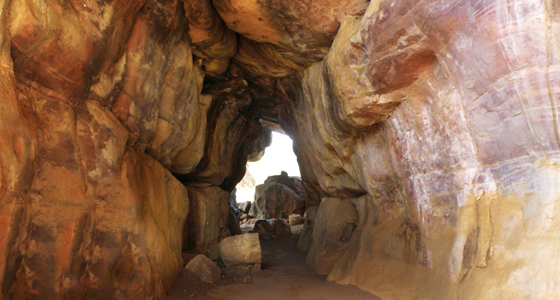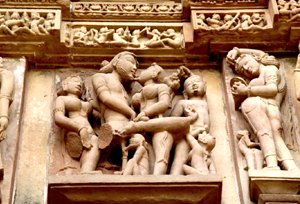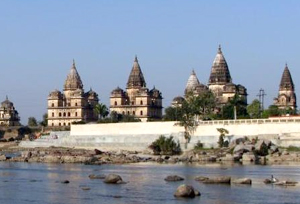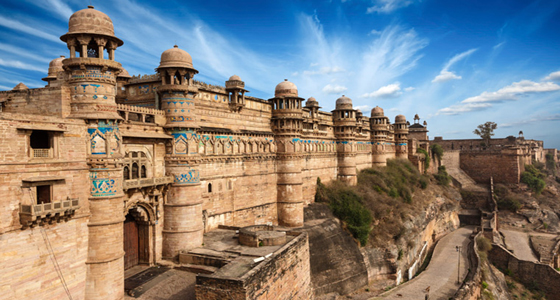The Central India tour will take you on a visit to some of the splendid hidden tourist destinations. The tour offers a great insight into the cultural vividness of India. Explore the hidden treasures of Central India through our thoughtfully designed package that spans in the duration of 16 days and 15 nights. You will get a wonderful opportunity to visit various popular destinations like Delhi,Mathura,Agra,Gwalior,Datia,Orchha,Khajuraho,Chanderi,Sanchi,Bhopal,Bhimbetka , Bhojpur,Bhopal ,Ujjain, Indore Dhar, Mandu,Omkareshwar,Maheshwar,Jalgaon ,Ajanta, Aurangabad,Ellora,Mumbai. During the tour, you will be also exploring several popular tourist attractions like Marine Drive, Hanging Garden, Ajanta and Ellora caves, Mini Taj, Omkareshwar Temple, Bhimbetka Rock Shelters and more. So, enjoy the hidden treasures tour of Central India to the fullest.
Day 01: Arrive Delhi
On arrival at Delhi International airport meet with our representative and transfer to the hotel. Overnight stay at hotel.
Day 02:Delhi – Mathura, 165 km - Agra, 60 km
After breakfast leave for Agra. En-route visit Mathura – city associated with the most revered of Hindu Gods – Lord Krishna, which is sacred being the birth place of Lord Krishna. The surroundings 'Braj Bhoomi' is where Lord Krishna is supposed to have grown up. Further visit Archaeological museum. After visit leave for Agra. Upon arrival check into the hotel. Overnight stay at hotel.
Day 03: Agra– Gwalior, by train 
In the morning visit the famous Taj Mahal built by Mughal Emperor Shah Jahan in memory of his wife Mumtaz Mahal. This monument is made of white marble and it took 22 years to get constructed. Later proceed to visit the Agra Fort which has the Pearl Mosque, Diwan-e-am (the hall of public audience) and Diwan-e-Khas (the hall of private audience). After visit transfer to the railway station to board the train for Gwalior. Upon arrival at Gwalior railway station meet with our representative and transfer to the hotel. After fresh-n-up explore the city visiting Gwalior Fort, the Man Mandir Palace, the Jivaji Rao Scindia Museum, Sas Bahu Ka Mandir, the tombs of Tansen and Ghias Mohammed and the Sun temple. Overnight stay at hotel.
Day 04: Gwalior –Datia, 77 km – Orchha, 49 km 
After breakfast leave for Orchha. En-route visit Datia. Datia is an ancient town, mentioned in the epic Mahabharata as Dantavakra. The town is a market centre for food grains and cotton products. Handloom weaving is an important industry. Datia is a famed for the seven-storied palace built by Raja Bir Singh Deo in 1614. A pilgrimage spot for devotees, Datia has the sidha peeth of Shri Pitambara Devi, Bagalamukhi Devi Temple and Gopeshwar temple. After visiting Datia village tour, leave for Orchha. Upon arrival check into the hotel. After fresh-n-up visit Orchha - Orchha is a small town placed on the banks of River Betwa and accurately translates to "hidden place "and is a well-known traveler Destination. Orchha is residence to Bundella style of structural design and the palaces of Orchha bear observer to the magnificent work of medieval architects. The famous amongst this are Raj Mahal and Jahangir Mahal. The Raj Mandir - built on a square base has plain external with projecting windows. The Jahangir Mahal, built to welcome the Mughal emperor Jahangir is the magnificent example of Hindu structural design. The other attractions include the Raj Mahal, The Sheesh Mahal, the chaturbhuj temple. Along with these there are numerous Chhatris of royals or cenotaphs dotting the banks of the river Betwa. Overnight stay at hotel.
Day 05: Orchha – Khajuraho, 173 km
After breakfast leave for Khajuraho. Upon arrival check into the hotel. After fresh-n-up proceed on city sightseeing tour of Khajuraho to visit its magnificent temples. Khajuraho, is worldly known for its magnificent temples of erotica built between 950 A.D. and 1050 A.D. Khajuraho - is world heritage town, the temples are scattered in an area of 8 sq km. After relaxation take a sightseeing tour of Western group of Temples (Chandela Dynasty) consisting of the massive Laxman Temple dedicated to lord Vishnu, the Laxmi and Varaha temples dedicated to Vishnu’s consort Laxman, the Kandariya Mahadev temple dedicated to Lord Shiva and the Chausath Yogini temple dedicated to goddess Kali. Also visit Archaeological museum with its collection of stone sculptures of the Chandela dynasty. Overnight stay at hotel.
Day 06: Khajuraho - Chanderi, 230 km 
After breakfast leave for Chanderi. Upon arrival check into the hotel. After fresh-n-up proceed on tour of Chanderi visit Badal Mahal Gate, Koshak Mahal, Chanderi Fort, Kati Ghati and Archeological Museum etc.
Chanderi is a small historical town in Madhya Pradesh. It is gradually making a very important place for itself in the Indian tourism map. There are several Tourist Attractions in Chanderi that are all well worth a visit and attract a large number of tourists each year.
In the 11th century, Chanderi was a strategically important place. It was an important military outpost and also lay in the main trade route. Legend has it that at one point of time Chanderi was so thickly forested that Babur; the Mughal Emperor could trace the fort after searching the depths of the jungle for six months.
An annual fair is held each year in honor of Jaageshwari Devi and this is one of the major Tourist Attractions in Chanderi. The place is well known for the beautiful Chanderi saris that come in light colors and beautiful golden borders. Make sure that you pick up one when you visit the place. Overnight stay in Chanderi.
Day 07: Chanderi – Sanchi, 168 km – Bhopal, 49 km
After breakfast will leave for Bhopal. En-route we will visit Sanchi and explore its major attractions. On reaching Sanchi, we will start our day tour by visiting the famous Sanchi Stupas. Afterwards, we will head towards its other major attractions such as Salamatpur, Dewanganj and various other small villages that can surely add on to your overall experience. Further continue drive to Bhopal. Upon arrival check into the hotel. If time permit explore Bharat Bhawan, Indira Gandhi Rashtriya Manav Sangrahalaya, Laxmi Narayan or Birla Temple, Upper & Lower Lake and Jama Masjid etc. Overnight stay at hotel.
Day 08: Bhopal - Bhimbetka - Bhojpur - Bhopal
After breakfast drive to Bhimbetka, enroute visiting Bhojpur This place have the biggest shivling in world. After visiting temples, and enjoy to boat ride to cross river and visit another temple. After visiting continue your journey to Bhimbetka. Bhimbetka here superimposition of paintings shows that the same canvas was used by different people at different times. The drawings and paintings can be classified under seven different periods. Later return to Bhopal. Overnight stay at hotel.
Day 09: Bhopal – Ujjain, 192 km – Indore, 56 km
After breakfast drive to visit Ujjain. At Ujjain visit the Mahakaleshwar Mandir, Vedha Shala (Observatory), Navgraha Mandir, Kal Bhairav Mandir. After spending quite time at the temple return to Indore for overnight stay.
Day 10: Indore – Dhar - Mandu, 120 km
After breakfast we will visit some of the major attractions of the places such as Kanch Mandir, Lal Bagh Palace, Central Museum, Khajrana and Gomatgiri. Later drive to visit Dhar. Upon arrival explore Dhar visiting Dhar Fort, Bhoj Shala and Lath Masjid.
Dhar Fort: Located atop of a small hill, it is an attractive fortress made of sandstone. It is said that this fortress was built by Muhammad bin Tughluq, the famous Sultan of Delhi. One of its gateways which date back to almost 1684-85 was added during reign of Alamgir. Inside the complex of this fort there is deep rock-cut tank present which seems to be of ancient period. With the time, several additions were made by different rulers and at present most of the part of this fort are ruined. For visitors, an outdoor museum showcasing a small collection of temple fragments and several images which date back to medieval period is present in the palace area.
Bhoj Shala: It is a hypostyle hall situated next to Kamal Maula’s tomb in Kamal Maula Mosque in Dhar. Today it counts amongst the most popular tourist places in Dhar. Bhoj Shala was founded by K. K. Lele, Superintendent of Education in 1903 in the historical city of Dhar. He found Sanskrit and Prakrit inscriptions belonging to time of Arjunavarman in the walls of Kamal Maula Masjid. As per these inscriptions, it was clear that it belong to King Bhoja, who was the famous author of several works on grammar and poetics. Thus, Lele described this building as Bhoj Shala and it became one of most visited places of historical importance in Dhar.
Lath Masjid: Also known as 'Pillar Mosque' it is located south of the town. It was built by Dilawar Khan in 1405 and name of this masjid has been derived from its one pillar made of iron which is supposed to have been set up during 11th century. This pillar was approx. 13.2 m high as per most recent assessment. But, as it has fallen and broken, its three surviving parts have been displayed for visitors on a small platform outside the mosque. Lath Masjid is one of the most visited tourist places in Dhar. After visit return leave for Madu for Overnight stay.
Day 11: Mandu - Omkareshwar, 105 km – Maheshwar, 65 km
After breakfast drive to visit Asharfi Palace and Jahaz Mahal in Mandu.
Asharfi Palace: At the front of Jaami Mosque, there are ruins of Asharfi Palace. Initially it was to be the religious school of Jaami Mosque, but later it devoted to its producer Mehmood Khilji (1435 – 69 AD). There is a winning memorial (1443) at the north-east of the Palace, which Mehmood Khilji built over the win on Rana Kumbha, it’s a seven stories pillar of 150 ft height.Close to Asharfi Palace, there is a Fascinating Ram Temple; which was built by Maharani Sakarwar bai pawar in 1769 AD.
Jahaz Mahal: Although it is called a Ship Palace, it bears as much resemblance to a water craft as a rhinoceros did to the mythical unicorn; through the legendary one-horned horse was inspired by traveler’s tales of the Indian Rhino. But then the Afghans were never known for their sea faring skills. They probably gave their pleasure palace its fanciful name because ships conjure up images of uninhibited fun away from the prying eyes of the mainlanders, the fact that the Jahaz Mahal had two large lakes on either side of it, added to the Afghan’s illusion that it resembled a ship. It is clear that this palace, in spite of its size, was never meant to be lived in. Its ground floor has three ground floors with corridors in between, and narrow rooms at the far end, from the halls pavilions project over the Munj tank. These halls were lounges and the pavilions were places for people to enjoy the cool breeze that blew of the lake. The narrow rooms at the far end were changing rooms from those who wanted to swim in the pillared pool at the northern end. The terrace above was for the festive parties, with superb view of the lake in front. It, too, had a smaller swimming pool at one end and pavilions for more intimate conversations. In fact, year later, the Mughal Emperor Jehangir describes just such a party hosted by his beautiful wife Noor Jehan at which a great entertainment took place and the drunkards indulged themselves to excess such mass revels were necessary. Ghiyathud-din, the creator of the Jahaz Mahal, had to find ways to keep his dependants occupied. It is said that he had at one time 15,000 women of various classes in his seraglio. Five hundred beautiful and young Turkish females in men’s clothes and an equal number of Abyssinian females, all in uniform and armed, used to stand as guards to his right and left sides respectively. If interested drive to visit Omkareshwar. After visit return to Maheshwar for overnight stay.
Day 12: Maheshwar – Jalgaon, 240 km
After breakfast explore the temple of Maheshwar visiting Jaleshwar Temple, Narmada Ghat, Ahilyeshwar Temple etc. Later leave for Jalgaon. Upon arrival check into the hotel. Overnight stay at hotel.
Day 13: Jalgaon – Ajanta, 70 km – Aurangabad, 100 km
Early morning leave for Ajanta Caves (breakfast will be provided in Ajanta itself) - they are cut from the volcanic lavas of the Deccan trap in a steep crescent - shaped hillside in a forested ravine of the sahyadri hills, These caves are older than those at Ellora consisting of 24 monasteries and temples hewn out of solid rack. The wall paintings and frescoes of these caves are a wealth of colors, Proceed to Civic - cum - Cultural Complex, a gallery of local art and crafts and shopping complex. (Ajanta caves are closed on Monday). Later return to the hotel. After fresh-n-up enjoy local city sightseeing tour visiting Bibi Ka Maqbara - situated about 3 km from the city is Bibi Ka Maqbara, the burial place of Aurangzeb's wife, Rabia-ud-Durrani. It is an imitation of the Taj at Agra and due to its similar design, it is popularly known as the Mini Taj of the Deccan.
Also visit Panchakki (water mill), housed in the Dargah complex of Baba Shah Musafir, it is a 17th century an intriguing water mill, it is famous for its underground water channel, which traverses more than 8 km to its source away in the mountains.
After visit leave for Aurangabad. Upon arrival check into the hotel. Overnight stay at hotel.
Day 14: Aurangabad – Ellora , 30 km– Aurangabad – Mumbai, by train
After breakfast an excursion to Ellora Caves. The caves are over 2000 years old and consist of temples and monasteries hewn from rocks by Buddhist, Hindu and Jains monks and craftsmen. Ellora is a World Heritage Site and represents the epitome of Indian rock-cut architecture. The 34 "caves" - actually structures excavated out of the vertical face of the Charanandri hills. The 12 Buddhist (caves 1-12), 17 Hindu (caves 13-29) and 5 Jain (caves 30-34) caves, built in proximity, demonstrate the religious harmony prevalent during this period of Indian history. It is a protected monument under the Archaeological Survey of India. (Ellora caves are closed on Tuesday).
Later return to the Aurangabad railway station to board the train for Mumbai. Upon arrival at Mumbai railway station meet with our representative and transfer to the hotel. Overnight stay at hotel.
Day 15: Mumbai
Morning at 0845 hrs transfer from the Hotel to Gateway of India to take the catamaran for Elephanta Caves with an accompanied English Speaking Guide. Boat leaves at 0900 hrs. Enjoy a one-hour boat ride across Mumbai Harbour brings you to the lovely, green Elephanta Island. Here you visit some of the huge and intricately carved Cave Temples dating back to the 7th century and dedicated to the Sun God - Shiva. Large panels depict Episodes in his life. The central sculpture represents Shiva's three aspects as creator, preserver and destroyer. Return back to pier.
Afternoon we will proceed on an excellent sightseeing tour of Mumbai's most iconic sites starting with a visit to the Gateway of India; further we will visit The Prince of Wales Museum (now Chhatrapati Shivaji Maharaj Vastu Sangrahalaya), and a stop at Mani Bhavan, the house where Mahatma Gandhi used to stay during his visits to Mumbai.
We will also drive along the Marine Drive and visit the Hanging Gardens. Stop off at Colaba Causeway before returning to your hotel. Later transfer to the hotel for overnight stay.
Day 16: Mumbai - Departure
Transfer to the International airport on time to board the flight for onward destination.
Tour & services Ends.














